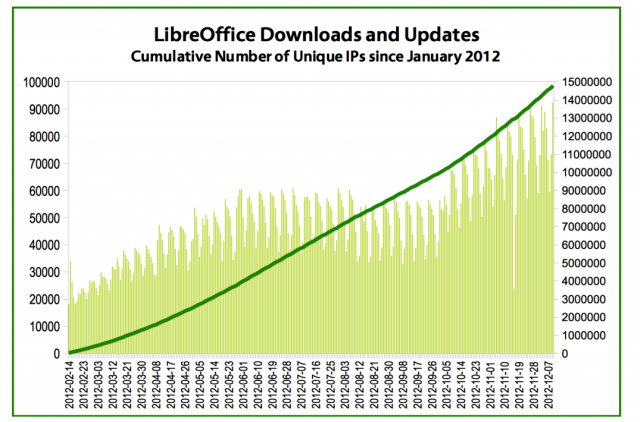
More than two years after LibreOffice came into being, it's hard to call the open source office software anything but a success. There are possibly tens of millions of people who use it—or at least have it installed on their computers. But how close is LibreOffice to overtaking OpenOffice, the king of open source productivity suites?
The short answer is that LibreOffice has a long way to go.
OpenOffice (which descended from Sun's StarOffice) has existed as an open source project for more than a decade. Concerns about OpenOffice's future after the Oracle/Sun merger led a core group of OpenOffice contributors to create LibreOffice, which is based on the same original code base but is getting more frequent updates than OpenOffice.
Oracle no longer controls OpenOffice, but the makers of the two office suites aren't working together. Oracle transferred control of OpenOffice to the Apache Software Foundation, while LibreOffice is maintained by the newly created Document Foundation.
To top it all off, there have been disputes about LibreOffice adoption figures, with one IBM employee and OpenOffice developer last fall writing a series of blog posts titled "LibreOffice's Dubious Claims."
There's little doubt that OpenOffice is still more widely used, but getting an exact count isn't simple. Let's take a look at what we know.
Counting open source usage a complex task
LibreOffice won over the makers of most major Linux-based operating systems, which now ship LibreOffice instead of OpenOffice as the standard office suite. But Linux users can download OpenOffice if they prefer it, and Linux in any case is only about 1 percent of the worldwide desktop market dominated by Windows (and Macs).
The Document Foundation recently announced that "rates of entirely new client IP addresses requesting updates each day [are] over the 100,000 mark," four times higher than at the same point last year.

I asked LibreOffice spokesman and Document Foundation co-founder Italo Vignoli to explain the significance of that number.
"People requesting updates have a working copy of LibreOffice pinging the servers," Vignoli wrote in an e-mail. "This means that they have downloaded LibreOffice (or they have got the package from a CD, a USB key, an alternative download site, or any other trusted source), they have installed the software and they are using the software (otherwise their PC would not ping the server)."
This generally accounts for individual users rather than corporate deployments. On the whole, "we can assume that out there are over 21 million individuals actively using LibreOffice with the update feature switched on," Vignoli said.
The numbers released by LibreOffice and OpenOffice aren't quite apples-to-apples, but they do suggest more interest in OpenOffice. OpenOffice 3.4 has been downloaded more than 40 million times since being released in May 2012. The 21 million figure of individual users of LibreOffice includes all the users racked up since LibreOffice became available in January 2011.
Then again, LibreOffice's method of counting theoretically includes only active users, leaving out those who downloaded the software and then discarded it.
Individual downloaders aren't the only source of adoption. There are corporate deployments, as well as users of Linux distributions that pre-install LibreOffice. Perhaps most users of distributions like Fedora and Ubuntu now use LibreOffice by virtue of it being the default option, but nothing is preventing them from using something else.
"In general, we estimate a figure very close to 100 percent of Linux desktops (which are also difficult to estimate but should be between 20 and 30 million), plus 30 to 40 million Windows users (based on downloads, migrations, requests for support and development), and a good number of MacOS users," Vignoli said. "Of course, these are estimates, and not unit figures based on license activations (and any estimate can be accurate or inaccurate, as the word estimate should imply, although there are people in other projects who imply that our estimates are cheating, which also explains why we are very shy about providing numbers we are not extremely confident about)."
OpenOffice adoption is still big, and growing
It stands to reason that there is a bigger base of existing OpenOffice users than LibreOffice ones, both among individuals and corporations, thanks to its long history and name recognition inside and outside the open source community. It's also beating LibreOffice on new downloads, as far as we can tell.
OpenOffice's published download stats show that it often hits 160,000 or 170,000 new downloads a day. On a "bad" day, the number might drop to 120,000.
Perhaps LibreOffice's figure of new downloads is higher than the 100,000 new IP addresses requesting updates each day, but we don't know based on the available data. "We are also working at getting a similar statistic for downloads, which measure the number of people who get the software but not the number of people who use it," Vignoli said. "We would of course like to provide the most accurate figures, but we are still a very young project (and we have been constantly upgrading our infrastructure during the course of the last two years, since we have launched LibreOffice)."
Controversy over LibreOffice adoption figures arose last October when Rob Weir, an OpenOffice contributor and IBM architect who works on the Open Document Format, wrote the aforementioned series of blog posts questioning "LibreOffice's Dubious Claims."
Whereas OpenOffice releases daily download rates, LibreOffice adoption numbers come "from download claims in press releases, and then only at long intervals," Weir wrote. "We have no idea what exactly they are counting. They have never made the detailed stats public. This does not mean that the numbers are incorrect, of course. It just means that no one outside of their project’s leadership is able to verify the claims."
Weir took the projects' total download numbers and calculated an average daily download rate of 29,460 for LibreOffice and 127,326 for OpenOffice.
Clearly, LibreOffice is enjoying much quicker adoption now. Weir's average was based on the total number of downloads of LibreOffice since January 2011, including the early days when LibreOffice was counting fewer than 10,000 new users a day.
Still, OpenOffice has "a massive brand advantage," LibreOffice developer Michael Meeks, an employee of Attachmate's SUSE business unit, told Ars. "They have a huge and valuable brand that we helped build for many years. It's an enduring sadness that they are not working with us. Clearly, they have more downloads, I think there's no doubt about that. But we're growing rather rapidly."
OpenOffice and LibreOffice combined are still just a minority of the total office market. Microsoft claims Microsoft Office is installed on more than 1 billion desktops worldwide, while Google claims tens of millions of users for Google Docs. (See also: Open source, Web-based office suite takes on Google Docs, LibreOffice.)
For Vignoli, it's not just about the numbers. "I do not think that the success of The Document Foundation and LibreOffice can yet be measured with numbers, because we have launched just 30 months ago and we are still growing at an incredibly fast rate," he said. "Today, we are listed amongst the largest free software projects, which is something that no one would have believed in September 2010."
reader comments
110